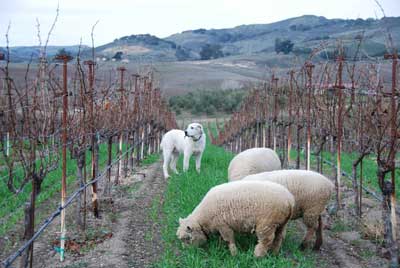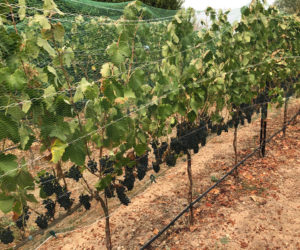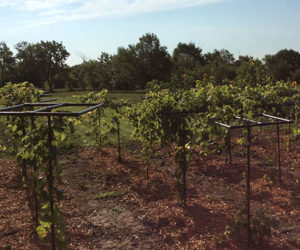Harvest/Post Harvest Quiz: With Pro-Inspired Conceptual Cheat-Sheets
Mark your answers and keep a running score in the margins. There will be a discussion of point totals at the end of the article.
- Assess the mildew/rot pressure of your vineyard through harvest:
Your score: ______
Pristine fruit, no sign of disease (4 points). One tiny incidence of disease which was quickly fixed with no apparent impact on fruit quality as a whole (3 points). Some mildew/rot, managed to bring in a mostly healthy crop (2 points). Mildew and/or disease impacted fruit quality, but wine was made (1 point). Disease/fungal issues severely impacted fruit quality or no harvest occurred (0 points).
Cheat sheet: Mildew and rot will begin affecting wine quality at less than 5% affected berries — so it’s vital they do not get into the fermenter or press. Mildew and rot are encouraged by humidity and heat and are much more likely to grow in crowded, shaded canopies. Mildew pressure is drastically reduced in open canopies with less than one leaf layer between the fruit and the sun and wind. Humid, warm temperatures between 75–85 °F (24–29 °C) are a perfect incubator for mildew and rot — so pay special attention to the weather and increase your spray frequency to the pressure. Both mildew and rot can perforate the skin of the grape and begin degrading freshness and flavor. During harvest you can address mildew and rot issues by showing your picking crew how to cut out parts of the affected clusters so the clean fruit goes in the bucket and the mildewed/rotted sections are cut onto the ground. The key to getting good mildew/rot control is choosing the right varietal (low rot/mildew potential in high pressure areas), using spray equipment that has the pressure and coverage that will get the fungicide into the canopy and onto the fruit, and timing your spray applications according to label directions (and sticking to a very regimented schedule. Note: Be wary of using overhead sprinklers/irrigation, as sprinkling the whole vineyard will inevitably cause problems with increased pressure for mildew and rot due to heightened humidity and increases spreading of spores. I find new growers have the most problems with rot and mildew. Once you get the rhythm of sprays firmly working a few seasons in a row, you should be educated and experienced enough to get a feel for what the vines need in your corner of the world.
- Did you harvest the grapes at your desired levels of sugar and acidity?
Your score: ______
Yes, weekly testing and careful observation enabled a perfect pick (3 points). Yes, but we picked a little late or early because of scheduling or missing a field test (2 points). Vineyard ripeness surprised us a bit at harvest, but we harvested the fruit and made wine without using large amounts of additions (1 point). We dropped the ball on testing the fruit and had to add significant amounts of sugar, acidity or both to fix the wine (0 points).
Cheat sheet: Sugar is converted into alcohol and carbon dioxide by primary fermentation (usually by a yeast called Saccharomyces cerevisiae). Wine yeasts, in my experience, convert sugar to alcohol at a rate of about 0.45-0.6% alcohol per Brix of sugar in the fruit. That means 20 °Brix = 12% alcohol at dryness, while 25 Brix will be closer to 15% alcohol in a dry wine. So for those who like their wines at about 14% alcohol, plan to pick around 23 Brix. Remember that red ferments tend to creep up after crush — sometimes as much as a +2 Brix soak up in the fermenter, especially if the fruit is dimpled or has raisins. As Brix climbs in summer and early fall, acid is respiring. The magic moment is when the sugar is high enough to make a rich wine, and the acid is strong enough to provide ample backbone. White wines above 3.4 pH usually taste a bit too soft for me, and red wines above 3.7 pH often strike me as “flabby.” Red wines with excellent tannins can make up for a lack of acidity by the structure and mouthfeel the tannins provide. If you need to add acid to a wine, do it as early as possible — make the additions to the juice or must, not the wine. The standard I learned: if you need to add water to a ferment to keep the alcohol moderate, add 7-10 grams of tartaric acid to each liter of water to be added.
- Do you have a way to measure Brix in your vineyard lab?
Yes (1 point). No (0 Points).
Cheat sheet: Brix can be measured easily with or without a lab in your house. Using a refractomer in the field is an easy way to teach your palate how to measure sugar. Walk a little while, choose a berry, squeeze some juice on the refractometer and taste the rest of the juice. What would you guess the Brix content is? 18? 20? Make your guess and then check your instrument. Repeat every year, and within a decade your mouth will be able to judge Brix within one or two points consistently. For a more accurate average of field ripeness, you need to take a sample of at least a few pounds of fruit. I fill about 1/3 of a 5-gallon (19-L) bucket for a field sample. I crush the fruit by “punching” the clusters down with my fist against the bottom of the bucket until I’ve made a juicy mess that doesn’t squinch and pop under my fist after a few minutes. I pour the white juice right off the skins into a pitcher or bowl, while I put a wet towel over the red samples, put them in a cool spot indoors, and allow them to soak up for about 24 hours. Getting an accurate sample of field ripeness before picking is a vital part of making harvest a success. Pour the juice sample into a large graduated cylinder and float a hydrometer in the juice. Do not allow foam to form on the top of the juice, blow it off if you have to, and read the Brix just below the meniscus.
- Do you send juice to a lab or have a way to measure pH or acidity in your vineyard lab?
Yes (1 point). No (0 Points).
Cheat Sheet: Acidity is usually described in juice and wine as either pH or TA (which I’ve seen described as both total acidity and titratable acidity, of which I prefer the latter for accuracy). The pH of juice or wine is a measure of the activity of hydrogen ions, while TA measures the actual weight of how much acid is in the liquid. Make sure to calibrate your pH meter every week or so in the testing period, and if it starts losing accuracy it may be time to replace the probe. Simple kits to test TA with sodium hydroxide titration are available from most lab companies and home winemaking supply stores.
- Do you pick your vineyard on the day when the fruit is perfect, or does the picking wait on a day opening up in your schedule?
Your score: ______
Pick when the fruit is perfect (2 points). Juggled my schedule a bit to pick, but wish I could have picked the exact date. (1 point). Wait on my schedule (0 points).
Cheat Sheet: I have made enough noise about this subject in previous articles. You’ve spent an entire year farming the fruit, and you really should pick it on the vines’ schedule of perfection, not when you get a day off. Call in sick, play hooky, whatever’s necessary. This is your wine we’re talking about!
- Have you tasted other local homemade wines and discussed harvest chemistry with the grower/winemaker?
Yes (1 point). No (0 Points).
Cheat Sheet: The importance of getting involved in the local wine culture cannot be overstated. Why reinvent the wheel when there are growers and winemakers in your county or state that can show you the way without muss or fuss? Seek out the local experts and help them first in their vineyards and take note of their tips and tricks. Bring your own wines and if your new friend(s) seem reluctant, ask them for their honest appraisal of your wines. A good way to ask them for tips is asking something like: “If this was your wine, how could you improve it?”
- Do you pick your grapes at night or early in the morning and crush them while as cool as they could be picked?
Yes, or also used dry ice and night/morning pick: (2 points). Dry Ice used to Chill after day pick: (1 point) No (0 Points).
Cheat Sheet: Picking grapes in the heat of the day puts you at a disadvantage. Hot grapes will be more likely to leak juice and begin spontaneous/feral ferments. If you have no choice but to pick in hot weather, find a good source of food-safe dry ice and chill the grapes or the must. Be careful adding dry ice to juice, as it has a tendency to foam and spit out of barrels or containers. Also make sure the space is properly ventilated to keep CO2 levels safe.
- Do you net your vineyard or have a way to keep the critters out?
Your score: ______
Yes, the fruit is pristine at harvest (3 points). Yes, but the critters always get up to 10% (2 points). Yes, but critters usually effect up to 25% of the fruit (1 point). Critters usually affect more than 25% of the fruit (0 points).
Cheat Sheet: Most vineyard owners have seen firsthand what birds and other pests can do to an unprotected vineyard. Bird netting is a great way to keep the winged types out, and if you roll up the extra netting and tie the bottoms up with tomato twine or twist-ties it also may exclude squirrels, raccoons and other critters that climb into the canopy for a snack. A few dogs in the backyard may help as well. Try to keep gophers under control with trapping or gas bombs, and deal with bees/wasps/yellowjackets early in the season to keep them from breaking the skins of those precious berries.
- Do you keep a notebook where you write down details of harvest chemistry, cultural practices, winemaking practices, etc. so you can correlate your years’ work with how the wine tastes?
Your score: ______
Yes, I keep a fairly complete record of all my winegrowing/making in a notebook or on a computer. (2 points). I make some chicken scratch while reading articles and books, and sometimes make winegrowing/making notes or print an article from the Internet to help. (1 Point) . No (0 Points).
Cheat Sheet: Having a record of what you do in the vineyard will help you adapt and fine tune your practices to improve your farming and wine quality every year. Make sure to read last years’ notes before making a plan for subsequent vintages!
- Do you educate yourself on a monthly basis on happenings in the viticulture and wine world?
Yes (1 point). No (0 Points).
Cheat Sheet: Check the list of suggested publications in the section of this article called “vineyard management basics.”
- Do you give your vines a deep irrigation right after harvest?
Yes (1 point). No (0 Points).
Cheat Sheet: Help the vines flush their roots after harvest. Apply ten to twenty gallons (38 to 76 L) per vine (in dry soils) right after harvest day. Vines react to losing their crop by starting a period of rapid root growth, and some nice, moist soil will enable them to be more efficient in this process.
Scoring your Success:
20+ Points. Why don’t YOU write my articles. You know your stuff and follow through like a pro. If your cellar practices are as solid as your growing know-how your wines should be bringing home gold medals and making you lots of friends (maybe even a groupie or two). You may have a dream of going pro — or taking my job in a few years.
15–19 Points: Engaged wine grape grower, make sure I taste your wines at the Conference! You’ve been paying attention and understand wine grape growing in a way that most home enthusiasts don’t. You are a solid student that uses learned concepts in the field, and your wine certainly improves as a result. Keep reading articles and filling those notebooks and visit as many vineyards and wineries as possible. If you pay close attention to the commercial wines you drink, you will be able to taste the quality of their vineyard management. Try not to call them and complain about haphazard canopy management.
11–14 Points: Good reader, keep digging and growing! You are beginning to take the lessons learned from travel and study into the vineyard and you are likely seeing an improvement in your homegrown wines. You may need to join a winegrowing club or spend a little more time observing your vineyard. Perhaps your spray intervals were a bit off and you see mildew/rot pop up in small sections of your backyard vineyard. Keep up the study and don’t forget to apply it in the vineyard — adapt your winegrowing plan and see your wines get better and better.
0–10 Points: Have a Desire to Learn and Keep at It! The quiz should inform you how to improve your vineyard cultural practices to continue improving the quality of your homegrown wines. It may be that you are more honest about your shortcomings as a grower than most, or you may be finding that growing grapes is a little more overwhelming than the romance you originally imagined. Walk the vineyard one more day per week to get your vines back on track. Instead of reacting to problems with mildew or pests, try to adapt your farming to predict and solve last years’ issues before they arise in 2019.






